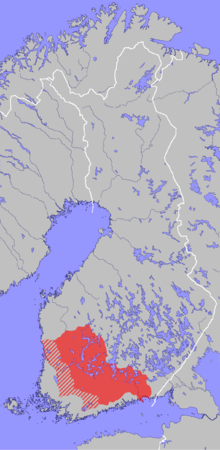Häme dialects
The Häme dialects (Finnish: hämäläismurteet ) are a group of dialects of the Finnish language . They belong to the West Finnish dialects.
The distribution area of the Häme dialects includes the south of the eponymous region Häme (i.e. the landscapes Pirkanmaa , Kanta-Häme and Päijät-Häme ) also the east of Satakunta and large parts of the Finnish-speaking areas of Uusimaa (including Ostuusimaa and Kymenlaakso ). The Häme dialects flow smoothly into the south-west Finnish dialects , but have also partly adopted elements of the neighboring Eastern Finnish Savo dialects , so that the different Häme dialects do not form a particularly homogeneous unit.
Linguistic features
The differences between the Häme dialects and the standard Finnish language are mainly phonological . The main features that characterize the Häme dialects are:
- The most important isogloss between Western and Eastern Finnish dialects is the equivalent of written d . In most of the Häme dialects, the sound has been replaced by l , in some regions also by an r ( tehlä or tehrä instead of tehdä “to make”).
- Schriftsprachlichem ts corresponds to the Häme dialects tt which is generally not the stage change subject ( metta - mettän instead metsä - Metsän ).
- The final sound sequences ea , eä , oa , öä have been simplified to ee , oo and öö ( corkee instead of korkea "high").
- The written diphthongs ie , uo , yö correspond to iä , ua , yä ( miäs , nuari , tyä instead of lousy “man”, nuori “young”, työ “work”).
- In contrast to the written language , intervowel h has often been preserved ( nälkähinen instead of nälkäinen "hungry").
- Written language tv is replaced by lv and lv ( lalva instead of latva "treetop").
- Sometimes in the Häme dialects a short vowel followed by rr corresponds to a diphthong or long vowel and r in the written language ( arra instead of aura "plow", terri instead of teeri "capercaillie"). In terms of language history, this goes back to the sequence tr .
- The personal pronouns use different forms of declension ( meitin instead of meidän “our”, teitille instead of part “you”).
- The demonstrative pronouns have the different forms toi , noi instead of tuo , nuo "those", "those".
- Verbs are often shortened ( en sa , ei o instead of en sano “I don't say”, ei ole “is not”).
literature
- Martti Rapola: Johdatus Suomen murteisiin . 2nd Edition. Helsinki: Suomalaisen Kirjallisuuden Seura, 1961.
